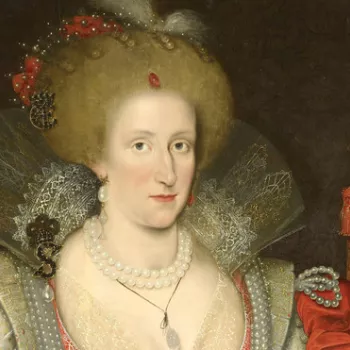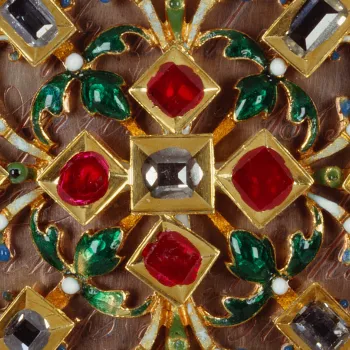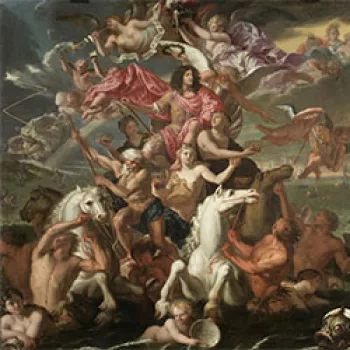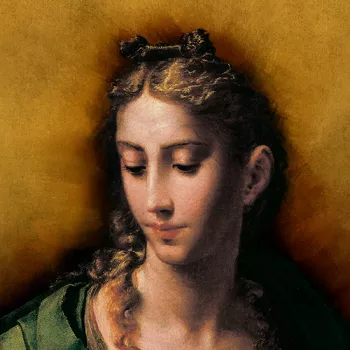Andrea Odoni Signed and dated 1527
Oil on canvas | 104.3 x 116.8 cm (support, canvas/panel/stretcher external) | RCIN 405776
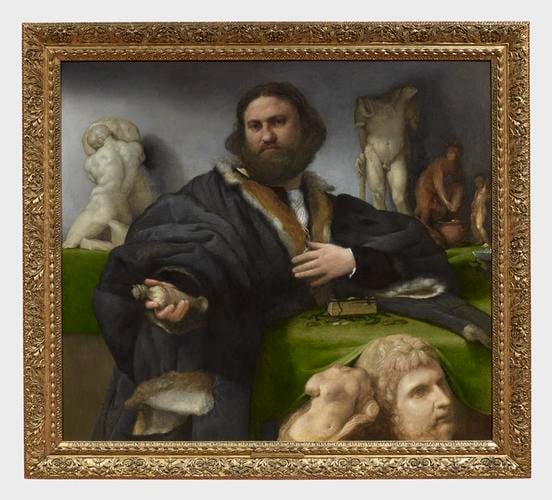
Lorenzo Lotto (Venice c. 1480-Loreto 1556)
Frame for RCIN 405776, Lotto, Odoni Signed and dated 1527
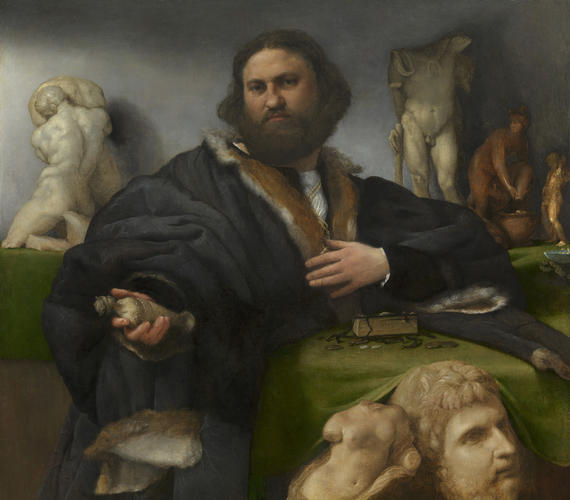
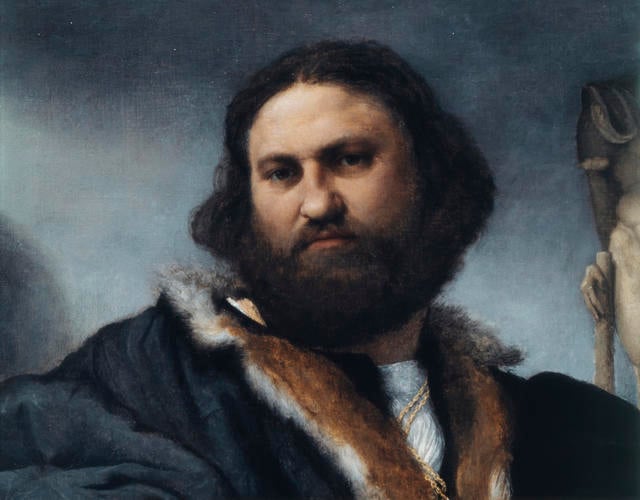
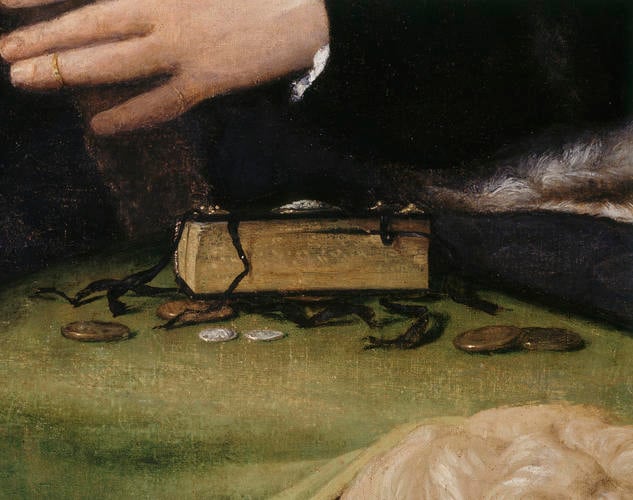



-
This portrait of the successful Venetian merchant Andrea Odoni (1488-1545) is one of the most innovative and dynamic portraits of the Italian Renaissance by Lorenzo Lotto, recently returned to Venice after thirteen years in Bergamo and anxious to impress possible patrons in Venice. The Venetian collector holds in one hand a statuette of Diana of Ephesus, symbol of nature and idolatry, and with the other he clasps a cross to his chest. One of several interpretations of this gesture is that Christianity takes precedence over nature and the pagan gods of antiquity.
The portrait has aptly been described as one of the finest and most ambitious of all of Lotto's portraits and a deliberate challenge to Titian's supremacy in the field. The portrait was recorded in the owner's bedroom in his house on the Fondamenta del Gaffero by Marcantonio Michiel when he visited the collection in 1532. Giorgio Vasari mentions the portrait 'che è molto bello', which he must have seen when he visited Venice ten years later. The painting was also included in the 1555 inventory of his brother and heir, Alvise Odoni.
The son of a wealthy recent Milanese immigrant to the city, Andrea Odoni was an important member of the cittadini. He built upon the collection which he had inherited from his uncle, Francesco Zio, to become a renowned collector of paintings, sculpture, antique vases, coins, gems and natural history specimens. This portrait was hung in Odoni's bedroom alongside The Virgin and Child with the Infant St John and a Female Saint or Donor, now in the National Gallery, London. The house also contained an unusual combination of ancient and modern statuary, with 'mutilated and lacerated antique marble heads and other figures'. Pietro Aretino (the poet and satirist) wrote to Odoni (in a letter of 1538) that he had re-created Rome in Venice, though elsewhere he describes the splendours of the house in a tone that suggests it overstepped the boundaries of Venetian decorum. Giorgio Vasari called Odoni's house 'a friendly haven for men of talent'.
Lotto had used a broad (here in fact nearly square) rather than vertical format already, but here it is used to fill the space around the sitter. Odoni's gaze is made more arresting by his powerful gesture, bulked out by his coat, and the weight of sculpture around him. Most of the sculpture has been identified as versions, probably plaster casts, of well-known originals. There are three representations of Hercules: Hercules and Antaeus (the fragmentary group in the Belvedere courtyard at the Vatican); the standing figure with a lionskin identified at the time as Emperor Commodus as Hercules (Musei Vaticani, Rome) ; and Hercules Mingens (derived from a lost prototype) on the far right. There are two representations of Venus: the torso in the foreground portrays an Aphrodite that was in the Veneto in the mid 16th century, now Museo del Liviano, Padua, and a Bathing Venus. In the foreground there is also a cast of the bust of Hadrian (probably made from the bust now in the Musei Capitolini, Rome rather than the bust in the Museo Nazionale, Naples). Odoni holds out a statuette of Diana or Artemis of the Ephesians in his right hand.
Of these only Hadrian's bust is known to have been in Odoni's collection, as it appears in his brother Alvise Odoni's inventory. The Venus torso may be ' a figure of a woman without a head' in the 1555 inventory. It has been suggested that the others were not in Odoni's collection, but rather belonged to Lotto: we know from Lotto's wills and account book that he owned plaster and wax reliefs and sculpture in gesso. The fragments must have been included in the painting because they were important to Odoni, or as a symbolic commentary on him. Although the originals from which they were copied are likely to have been fragments, their battered state seems to have been emphasised by Lotto and their arrangement challenging and ironic, the Hercules Mingens placed facing the Bathing Venus, the torso of Venus in the foreground against the bust of Hadrian.
It has always been recognised that the meaning of the painting is more complex than simply the portrait of a collector, but this continues to be much debated. Odoni's direct gaze at the viewer and the contrast between the hand held to his heart and the proffered statuette of Diana have suggested to scholars that a choice is being proposed to the viewer. The contrast between this complete object, symbol of nature or earth, and the antique fragments has been seen as representing the enduring power of nature compared with the transitory character of art and human endeavour, one of many interpretations on the theme of nature and art that have been put forward. The cross held by Odoni against his chest suggests that for Odoni the true religion of Christianity, represented by the cross, will always take precedence over nature and the gods of pagan antiquity, symbolised by the statuette of Diana and the other classical fragments.
It has also been proposed that Lotto intended a relationship between the bust of the Emperor Hadrian, the great patron of the arts in ancient Rome, and Odoni as the new patron of the arts. Michiel changed his description from 'with ancient marble fragments', to 'who contemplates ancient marble fragments', and it has been suggested that rather than being about one choice the painting is a meditation on many themes of collecting. The many meanings would have been discussed by Odoni's circle of erudite friends, including Pietro Aretino. Aretino's praise that Odoni had recreated Rome in Venice may explain the stress in the portrait on those antiquities that were owned by Odoni (or at least were in the Veneto) which are prominent in the foreground, as against those in Rome relegated to the background. Lotto may also be comparing his own art as a Venetian painter to the ancient masters of sculpture and that he has brought the ancient sculptures to life through his art. Contrasts between Rome and Venice, pagan and Christian, nature and artifice, ancient and modern, painting and sculpture can all be contemplated in this innovative portrait.
Catalogue entry adapted from The Art of Italy in the Royal Collection: Renaissance and Baroque, London, 2007Provenance
Andrea Odoni; his brother, Alvise Odoni by 1555; Lucas van Uffelen, probably by 1623; Gerard Reynst, Amsterdam, 1639; acquired by the States of Holland and West Friesland and presented to Charles II in 1660
-
Creator(s)
Acquirer(s)
-
Medium and techniques
Oil on canvas
Measurements
104.3 x 116.8 cm (support, canvas/panel/stretcher external)
122.9 x 136.3 x 5.8 cm (frame, external)
100.0 x 113.4 cm (sight)
Category
Object type(s)
Other number(s)
Alternative title(s)
Self-portrait of Giorgione, previously identified as
Portrait of Bandinelli, previously identified as
Portrait of Andrea Odoni






